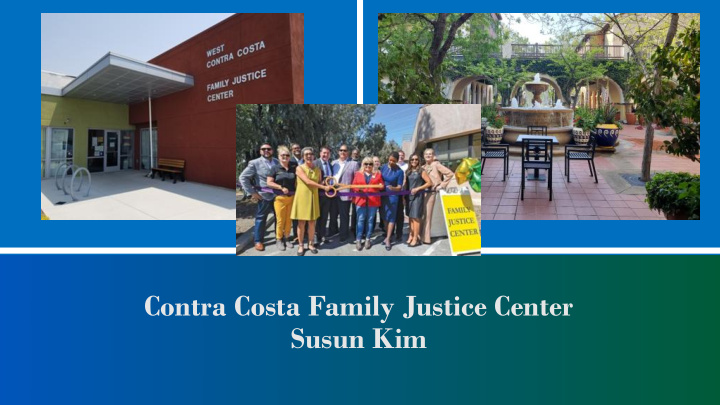



Contra Costa Family Justice Center Susun Kim
SOME NUMBERS Domestic Violence • 1 in 4 women • 1 in 7 men • 54% of mass shooting cases involve DV or family violence Sexual Assault • 1 out of 6 women: victims of rape or attempted rape in her lifetime; 1 in 33 men • 33% rape victims contemplate suicide; 13% attempt suicide.
MORE DATA Child abuse • Boys who witness DV are twice as likely to abuse their partners and children when they become men. Elder abuse • 2/3 of victims are female • More than half of perpetrators are family members • Most common form: financial elder abuse
A FRACTURED SYSTEM Peer Counseling Restraining Order Assistance Assistance With Emergency Shelter Victims of Crime Compensation Program Court Safety Law Enforcement Support Planning Assistance
FAMILY JUSTICE CENTER STAFF AND PARTNERS • 17 Staff : 2-3 Navigators at each Center; 10 out of 17 speak Spanish • 53 MOU partners • 9 law enforcement agencies • 8 County and City agencies • 36 non-profit partners • 10 Lawyers for Family Justice
HISTORY AND BACKGROUND 2001 2011 2015 2016 2019 SB 968 declares Contra West Family Justice Central Family Justice New non-profit’s 13- Opened East Family Costa County the first Center pilot opened in Grand Opening in March member board seated in Justice Center. Zero Tolerance for Richmond September Domestic Violence County in California (now Alliance to End Abuse) Planning efforts for West Planning efforts for Central West Family Justice Center Family Justice Center Family Justice Center moved to permanent site in Planning for East Family began began May Justice Center 2009 2014 2015 2018
CLIENTS SERVED These are families from the first 6 months in 2020. We anticipate 5,000 by the end of 2020.
COVID–19 and IPV Loss of Jobs – economic crisis No safety net for undocumented immigrants DV shelters not accepting new clients APS and CFS reports down 18% increase in number of clients in first 6 months
RECENT EVENTS June 2020 July 2020
COMING EVENTS Building Safety Through Community 30 Minutes a Day!
A project of the Family Justice Center Interpersonal Violence and Persons with Disabilities*
Persons with Disabilities • For this project, we use the term “persons with disabilities.” This is the term used by the funder and is generally used to describe the population we are serving. • We recognize that there are better and more respectful terms. Our project includes members of the Deaf community and people who do not identify as having a disability and have the need for support services.
Interpersonal Violence and The issue: Persons with • Crime victims with disabilities have Disabilities been virtually invisible. • Greater understanding by all is foundational to addressing the unmet needs of this underserved Denying community. access to • Victim services, criminal justice and justice is disability communities must come injustice. together to identify approaches to reaching these victims.
Interpersonal Violence and There were four methods identified in Persons with the Joint Statement on Crime Victims with Disabilities** to address the needs Disabilities of this population: 1. Expanded research The disability 2. Public policy changes is not the problem. 3. Greater public education 4. Increased access to programs and The services accessibility is Our Project addresses 3 and 4 by the problem developing a Communication and Outreach Plan. Mohamed Jemni #TED2013 **National Council on Disability, Association of University Centers on Disabilities and the National Center for Victims of Crime developed a Joint Statement in 2007.
Interpersonal Violence and Our process: Persons with • Survey former clients of Family Disabilities Justice Center regarding access to our services • Survey persons with disabilities Th There i is s only nly through the Independent Living ONE W E WAY AY t to Resources LOOK OOK a at thi things un unti til • Survey care providers and personal representatives of persons with SOM OMEON ONE disabilities sho hows us us HO HOW W to to look at at them them • Survey our partners regarding their with wit practices DIFFERE RENT NT EY EYES ES. -Pablo Picasso
Interpersonal Violence and Working with our Disability Advisory Persons with Council: Disabilities • We will use the feedback we receive from the surveys to develop a Communication and Outreach Plan “We nee need to to that addresses improving access to make e e ever ery our services. sing ngle thi thing • We will make this plan available to acc accessible to to our partners. ever ery s sing ngle • We will develop tools and best person w on with a h a practice protocols. disabilit ility.” Stevie Wonder Musician and Activist
Interpersonal Violence and Persons with Disabilities
Recommend
More recommend